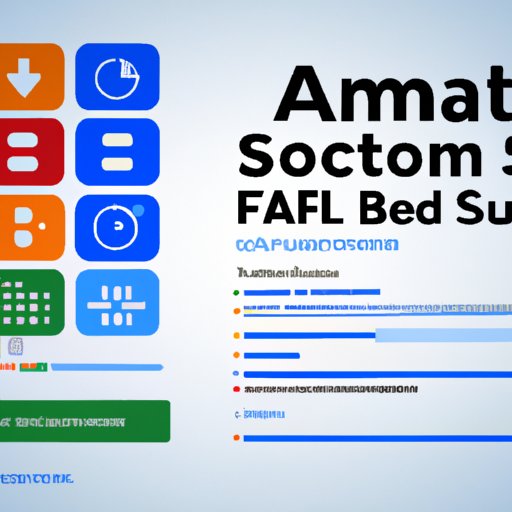Introduction
Spreadsheets are an invaluable tool for organizing and managing data. However, manually entering, updating, and manipulating data in spreadsheets can be time consuming and tedious. Fortunately, there are several ways you can automate your spreadsheets, saving you time and effort. In this article, we’ll explore the different methods for automating a spreadsheet, including creating macros, utilizing formulas and functions, leveraging Google Sheets add-ons, and employing third-party automation software solutions.
Definition of Automating a Spreadsheet
Automating a spreadsheet involves using various methods to reduce the amount of manual data entry, manipulation, and analysis required. Automation can range from simple tasks like repeating the same action multiple times to complex tasks like linking data sources and performing advanced calculations. Automating a spreadsheet can help streamline data management processes, improve accuracy, and save time.
Benefits of Automating a Spreadsheet
There are many benefits to automating a spreadsheet, including:
- Reduced time spent on manual data entry and manipulation
- Increased accuracy of data
- Improved data organization and consistency
- Greater efficiency when analyzing data
- Enhanced ability to identify trends and patterns in data
Create a Macro to Automate Spreadsheet Tasks
A macro is a set of instructions that tells a computer program (in this case, a spreadsheet) what to do. Macros can be used to automate repetitive tasks, such as formatting cells or inserting data. Creating a macro requires writing code that tells the spreadsheet what to do. Here’s a look at how to create a macro and some tips for making it effective.
What Is a Macro?
A macro is a set of instructions written in code that tells a computer program what to do. In the context of spreadsheets, macros can be used to automate repetitive tasks, such as formatting cells, inserting data, or performing calculations. Macros are often used to speed up data processing and make it easier to analyze and visualize data.
How to Create a Macro
Creating a macro requires writing code that tells the spreadsheet what to do. The code is usually written in a programming language such as Visual Basic for Applications (VBA). To create a macro, first open the spreadsheet and click on the “Developer” tab. Then, click “Record Macro.” This will open a window where you can enter a name and description for the macro.
Next, you can start recording the macro by clicking the “Start Recording” button. As you perform the desired task (such as formatting cells), the macro will record each action you take. Once you’re finished, click the “Stop Recording” button. The macro is now ready to use.
Tips for Creating an Effective Macro
- Make sure you understand the task you want to automate before writing the code.
- Test the macro after you’ve written it to make sure it works correctly.
- Break down complex tasks into smaller, more manageable steps.
- Use descriptive variable names to make the code easier to read.
- Comment your code to explain what each section does.

Utilize Formulas and Functions for Automation
Formulas and functions are pre-written instructions that tell a spreadsheet how to calculate or manipulate data. They can be used to automate tasks such as calculating totals, finding averages, or sorting data. Here’s a look at how to use formulas and functions for automation and some tips for making them effective.
What Are Formulas and Functions?
Formulas and functions are pre-written instructions that tell a spreadsheet how to calculate or manipulate data. They are typically written in a programming language such as Excel’s formula language or Visual Basic for Applications (VBA). Formulas are used to perform calculations, while functions are used to manipulate data (such as sorting or filtering).
How to Use Formulas and Functions
Using formulas and functions is relatively straightforward. First, open the spreadsheet and select the cell where you want to enter the formula or function. Then, type in the formula or function and press Enter. The spreadsheet will automatically calculate the result based on the formula or function you entered.
Tips for Using Formulas and Functions Effectively
- Understand the task you want to automate before writing the formula or function.
- Test the formula or function after you’ve written it to make sure it works correctly.
- Break down complex tasks into smaller, more manageable steps.
- Use descriptive variable names to make the formula or function easier to read.
- Comment your code to explain what each section does.

Use Visual Basic for Applications for Automation
Visual Basic for Applications (VBA) is a programming language used to automate tasks in Microsoft Office applications, including spreadsheets. It is a powerful tool that can be used to create macros, write custom functions, and link data sources. Here’s a look at how to get started with VBA and some tips for writing efficient VBA code.
What Is VBA?
Visual Basic for Applications (VBA) is a programming language used to automate tasks in Microsoft Office applications, including spreadsheets. It is a powerful tool that can be used to create macros, write custom functions, and link data sources. VBA can help streamline data processing and make it easier to analyze and visualize data.
How to Get Started with VBA
Getting started with VBA is relatively easy. First, open the spreadsheet and click on the “Developer” tab. Then, click “Visual Basic.” This will open the Visual Basic Editor, where you can begin writing code. You can also view and edit existing macros by opening the “Macros” dialog box. Once you’ve written the code, you can run the macro to see the results.
Tips for Writing Efficient VBA Code
- Make sure you understand the task you want to automate before writing the code.
- Test the code after you’ve written it to make sure it works correctly.
- Break down complex tasks into smaller, more manageable steps.
- Use descriptive variable names to make the code easier to read.
- Comment your code to explain what each section does.

Use Automated Tools like Zapier or IFTTT to Connect Data Sources
Automated tools like Zapier and IFTTT can be used to connect data sources and automate tasks. These tools allow you to create “recipes” that link two or more data sources, allowing you to transfer data between them. Here’s a look at how to set up automated tools and some tips for using them effectively.
What Are Automated Tools?
Automated tools are programs that can be used to connect data sources and automate tasks. Examples of automated tools include Zapier and IFTTT. These tools allow you to create “recipes” that link two or more data sources, allowing you to transfer data between them. For example, you could use an automated tool to transfer data from a spreadsheet to a database.
How to Set Up Automated Tools
Setting up automated tools is relatively straightforward. First, sign up for an account with the tool you’re using. Then, follow the instructions to set up the connection between the data sources you want to link. Finally, create the “recipe” that tells the tool what to do when the data sources are connected. Once the recipe is created, the automated tool will begin transferring data between the data sources.
Tips for Using Automated Tools Effectively
- Make sure you understand the task you want to automate before setting up the automated tool.
- Test the automated tool after you’ve set it up to make sure it works correctly.
- Break down complex tasks into smaller, more manageable steps.
- Carefully review the settings to make sure the data is being transferred correctly.
- Regularly monitor the automated tool to ensure it is running smoothly.
Leverage Google Sheets Add-ons for Automation
Google Sheets add-ons are small programs that can be used to automate tasks in Google Sheets. They can be used to link data sources, create charts and graphs, and perform calculations. Here’s a look at how to install and use add-ons and some tips for using them effectively.
What Are Google Sheets Add-ons?
Google Sheets add-ons are small programs that can be used to automate tasks in Google Sheets. They can be used to link data sources, create charts and graphs, and perform calculations. Some popular Google Sheets add-ons include Power Tools, Awesome Table, and Supermetrics.
How to Install and Use Add-ons
Installing and using Google Sheets add-ons is relatively easy. First, open the spreadsheet and click on the “Add-ons” tab. Then, select the add-on you want to use and follow the instructions to install it. Once the add-on is installed, you can use it to automate tasks in Google Sheets.
Tips for Using Add-ons Effectively
- Make sure you understand the task you want to automate before installing the add-on.
- Test the add-on after you’ve installed it to make sure it works correctly.
- Break down complex tasks into smaller, more manageable steps.
- Carefully review the settings to make sure the data is being transferred correctly.
- Regularly monitor the add-on to ensure it is running smoothly.
Employ Third-Party Automation Software Solutions
Third-party automation software solutions can be used to automate tasks in spreadsheets. These solutions can be used to link data sources, create macros, and generate reports. Here’s a look at how to choose the right solution for your needs and some tips for implementing it.
What Are Third-Party Automation Software Solutions?
Third-party automation software solutions are programs that can be used to automate tasks in spreadsheets. Examples of third-party automation software solutions include Excel Automation Suite and Automate.io. These solutions can be used to link data sources, create macros, and generate reports.
How to Choose the Right Solution for Your Needs
Choosing the right automation software solution for your needs can be challenging. Start by identifying the tasks you want to automate and the features you need. Then, research different solutions and compare their features and pricing. Finally, test the solutions to make sure they meet your requirements.
Tips for Implementing Third-Party Automation Solutions
- Make sure you understand the task you want to automate before implementing the solution.
- Test the solution after you’ve implemented it to make sure it works correctly.
- Break down complex tasks into smaller, more manageable steps.
- Carefully review the settings to make sure the data is being transferred correctly.
- Regularly monitor the solution to ensure it is running smoothly.
Conclusion
Automating a spreadsheet can help streamline data management processes, improve accuracy, and save time. There are several methods for automating a spreadsheet, including creating macros, utilizing formulas and functions, leveraging Google Sheets add-ons, and employing third-party automation software solutions. By understanding these methods and following the tips outlined in this article, you can successfully automate your spreadsheets and save yourself time and effort.
Summary of Automating a Spreadsheet
Automating a spreadsheet involves using various methods to reduce the amount of manual data entry, manipulation, and analysis required. There are many benefits to automating a spreadsheet, including reduced time spent on manual data entry and manipulation, increased accuracy of data, improved data organization and consistency, greater efficiency when analyzing data, and enhanced ability to identify trends and patterns in data. Methods for automating a spreadsheet include creating macros, utilizing formulas and functions, leveraging Google Sheets add-ons, and employing third-party automation software solutions.
Final Thoughts on Automating a Spreadsheet
Automating a spreadsheet can help streamline data management processes, improve accuracy, and save time. By understanding the various methods for automating a spreadsheet and following the tips outlined in this article, you can successfully automate your spreadsheets and save yourself time and effort.
(Note: Is this article not meeting your expectations? Do you have knowledge or insights to share? Unlock new opportunities and expand your reach by joining our authors team. Click Registration to join us and share your expertise with our readers.)
